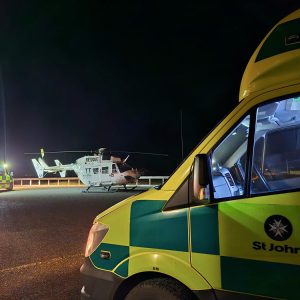RELATIVELY clear conditions meant the Trust Tairāwhiti Eastland Rescue Helicopter was able to fly five of its eight missions for the week under cover of darkness.
“The team still has to operate under Visual Flight Rules (being able to see the ground) but this is where equipment like their Night Vision Goggles really comes into play,” says Eastland Helicopter Rescue Trust chair Patrick Willock.
“It’s all costly . . . everything in the aviation and health sectors is. But their being able to fly missions at all hours, weather permitting, is why we are so committed to ensuring they have the right gear to carry out their life-saving work.”
The team’s mission log for the seven days starting Monday, June 3:
– June 3, 2024, 3am – The Trust Tairāwhiti Eastland Rescue Helicopter responded to a medical event at Ruatoria, flying the patient in serious condition to Gisborne Hospital.
– June 3, 2024, 12.12pm – They were dispatched to a trauma at Te Kaha, from where the patient was flown in stable condition to Tauranga Hospital.
– June 4, 2024, 10am – The team was called to a medical event at Tokomaru Bay, flying the patient in stable condition to Gisborne Hospital.
– June 4, 2024, 11.05pm – They attended a trauma at Ruatoria, and flew the patient in stable condition to Gisborne Hospital.
– June 5, 2024, 10.30am – The team returned to Ruatoria in response to a medical event, flying the patient in stable condition to Gisborne Hospital.
– June 6, 2024, 10.30pm – And they once again headed to a medical event in Ruatoria, flying the patient in serious condition to Gisborne Hospital.
– June 7, 2024, 2.30am – The team was dispatched to a medical event at Mahia, from where the patient was flown in serious condition to Gisborne Hospital.
– June 8, 2024, 6.30am – And for their final mission for the week they responded to a medical event at Ruatoria, flying the patient in stable condition to Gisborne Hospital.
The appearance that many events happen in East Coast townships, and that many patients are stable, is largely due to reporting protocol, Mr Willock says.
“For example, events are likely to take place in the hinterlands but there is a very active East Coast Hato Hone St John service that can often get patients to a helipad without compromising their care,” he says.
“And in terms of patient condition, they might be suffering a catastrophic event but our critical care flight paramedics work hard to get them as stable as possible before taking to the air.”
CAPTION: NIGHT FLIGHTS: Five of the Trust Tairāwhiti Eastland Rescue Helicopter’s eight missions for the week were flown under cover of darkness.
